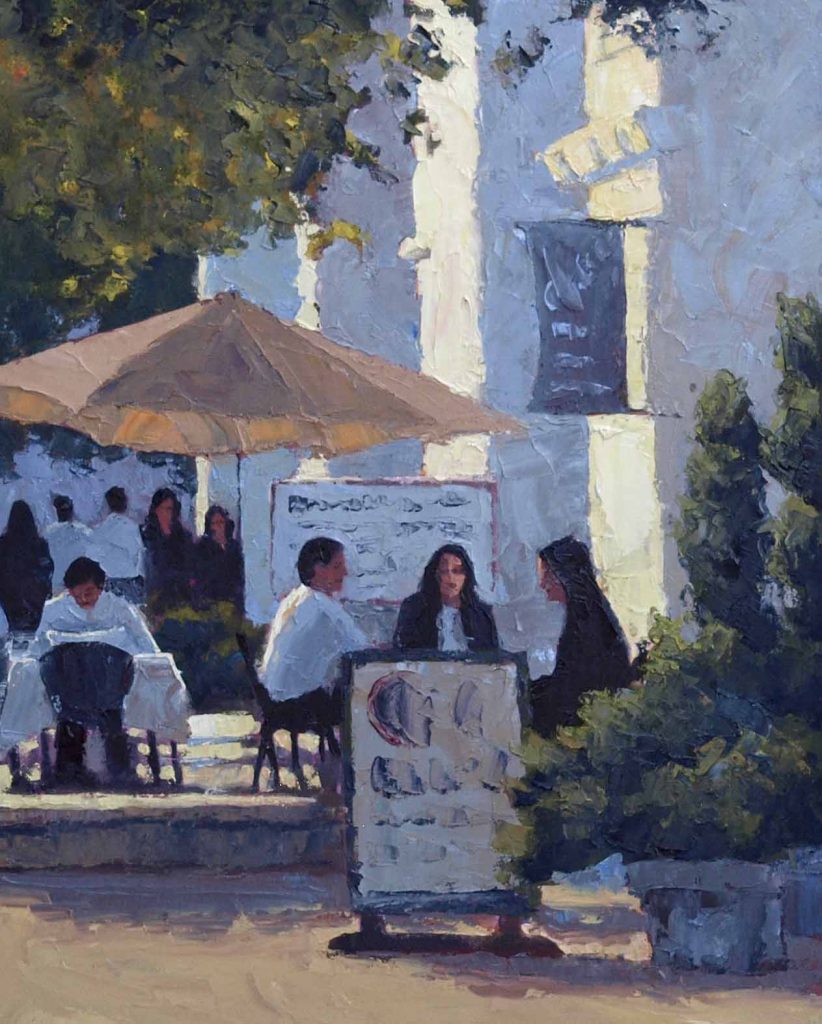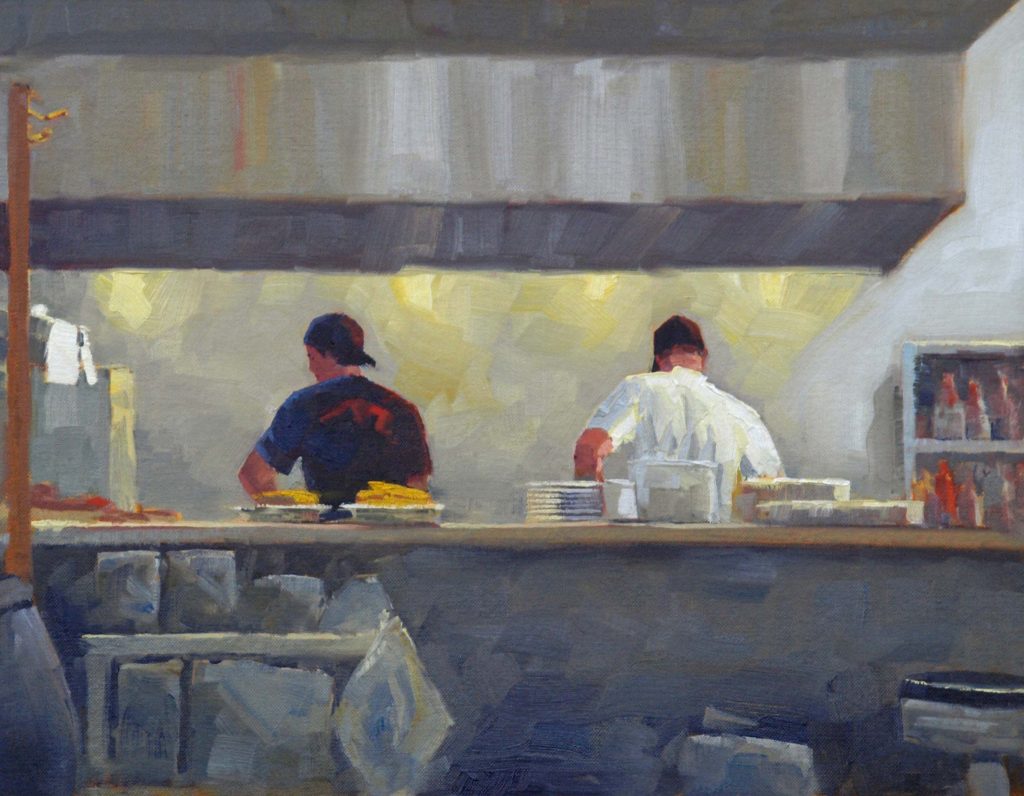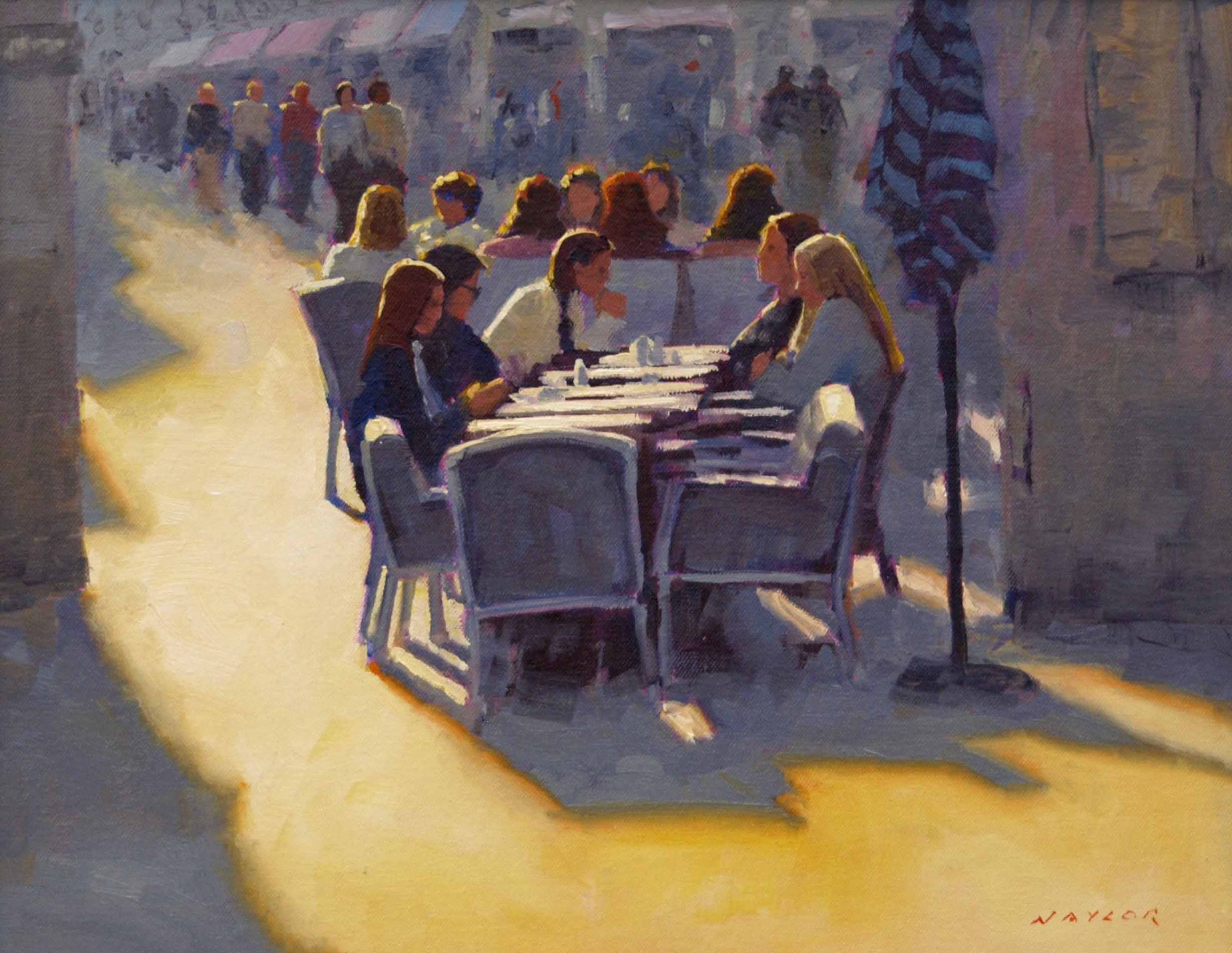The beautiful paintings of Rodgers Naylor’s collection “The Café Life” inspire a cozy feeling in the Susan Calloway Fine Arts gallery. The bright colors and happy scenes glow against the white walls. Even Naylor himself is radiating warmth as he stands in the middle of the gallery, comfortable in a snug sweater with a coffee in one hand. He is surrounded by his depictions of “café society,” a concept that refers to the role of cafés in Parisian life during the 19th and 20th centuries. The paintings in “The Café Life” collection show how this concept continues to be a defining feature of contemporary social activity in urban settings.
Naylor’s goal with this collection is simple: to portray the goodness of humanity. He says, “I’m trying to depict the sort of cozy, warm side of human life: the camaraderie, the togetherness, and the warmth—the human warmth.” Café society is an unequaled reflection of this side of life because it depicts family, friends, and strangers gathering around the table to eat, drink, and enjoy each other’s company. Two complementary paintings in the collection are entitled “The Feast of Reason” and “The Flow of Soul” in reference to a famous quote from Alexander Pope’s collection of poems Imitations of Horace. The significance of these titles parallels the main theme: that café society brings people together for lively debate, honest discourse, and human connection.

Rodgers Naylor
To bring these ideas to life, Naylor began by photographing scenes of café society that he found to be enjoyable, ranging from a group of friends sitting together outside a coffee shop in Paris to a couple of strangers on a quiet morning in an American diner. After he captured the scenes he wanted to recreate, he started painting, focusing especially on the use of color. Naylor primed the blank canvas with a warm color like yellow or orange, sometimes even using a light red. The final product inevitably had a warm glow to it as the light colors shone underneath the details of the painting. Even the frames around the paintings were primed with red and then covered over, making the warm colors of the painting appear even more vibrant.
Naylor subsequently painted over the base color with visible brush strokes and varying degrees of texture. He used heavy texture in the areas that he wanted viewers to focus on. In some paintings this method created an almost three-dimensional effect, while in others it simply sharpened the targeted areas. Naylor’s style is also notable for the large brushstrokes visible in his work. Rather than blending all of the colors together and erasing signs of the creation process, Naylor lets the audience see his artistic hand at work. In this way, viewers can connect with him and follow the movements of his brush as he painted.

Rodgers Naylor
Warm colors, varied texture, and noticeable brush strokes are all essential components of creating light in the paintings. Light plays a vital role in Naylor’s collection because it helps set the mood for the audience. Naylor utilizes a wide variety of lighting in his paintings ranging from full, overhead sunlight to an evening ambience to an artificial incandescence. The light in “Market Café” is particularly remarkable because the angle of the sun produces hazy shadows, adding another dimension to an already captivating outdoor scene. Furthermore, “Under the White Umbrella” shows a café at the height of the afternoon when the sun is high in the sky and its golden rays can be seen reflecting off of the glass windows. Each portrayal of light evokes different emotions within the audience from the hopeful yearning for a summer day to the tranquilizing effect of interior light.
A central theme in this collection is ambiguity. Although all of the paintings are based on photographs from real places, the locations aren’t listed with them. This allows the viewers to ponder about where they think it is or where they want it to be. Likewise, the specific details of the paintings, like the faces of the people, are blurred and obscured. This vagueness creates space for imagination and enhances the experience of the viewers, who can weave their own interpretation of the art. Naylor said, “When I am looking at a painting, it is fun for me if I am imagining who the people might be and what they are up to and what their background is and what is going on around them. If I tell the viewer all that, then there’s nothing left for them to do.” In the spirit of creativity, Naylor leaves the details of the scene sufficiently unclear so that the audience has a chance to interact with the work.
The paintings featured in Rodgers Naylor’s “The Café Life” elicit intrigue, happiness, and warmth. The artist uses rich color and bold light to magnify harmonious scenes of human interaction. The collection mirrors hope and love in modern society, leaving viewers feeling full, as if they, too, had just enjoyed a satisfying meal, a hot cup of coffee, and a vibrant discussion with good friends.





